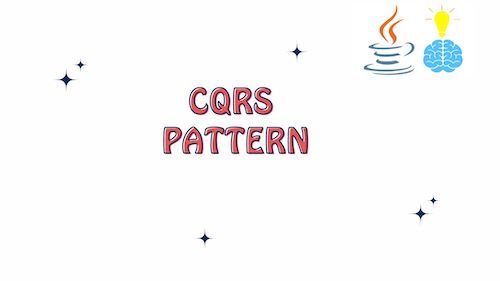In this article, we will explore CQRS Pattern in great details.
What is CQRS Pattern?
CQRS Pattern(Command Query Responsibility Segregation) is an architectural pattern that separates the responsibilities of handling commands (which change the state of an application) and queries (which retrieve data from an application) into separate models.
In a traditional application, the same model is used to handle both commands and queries.
With CQRS, the application is separated into two distinct models: the Command Model and the Query Model.
The Command Model is responsible for handling commands, which change the state of the application. It is typically implemented using a domain model and an object-relational mapper (ORM).
The Query Model, on the other hand, is responsible for handling queries, which retrieve data from the application. It is typically implemented using a denormalized data model, such as a document database or a search index.

Benefits of CQRS Pattern
- The primary benefit of using CQRS Pattern is that it allows for a more flexible and scalable application, as the Command Model and Query Model can evolve independently of each other.
- Additionally, it also allows for better performance as the query model can be optimized for read-heavy workloads, while the command model can be optimized for write-heavy workloads.
How to synchronize the command and query databases?
In CQRS pattern, the command side and the query side typically use separate databases. This allows for greater flexibility and scalability in the system, as the read and write concerns can be optimized independently. However, it also introduces the challenge of keeping the two databases in sync.
There are several ways to synchronize the command and query databases in CQRS pattern:
- Event Sourcing: One approach is to use event sourcing to store the state of the system. In event sourcing, the state of the system is represented as a sequence of events, rather than a snapshot of the current state. The command side generates and stores these events, and the query side uses them to rebuild and maintain the read model.
- Database Replication: Another approach is to replicate the data from the command side database to the query side database. This can be done using a variety of replication technologies, such as master-slave replication or log-based replication.
- Asynchronous Messaging: A third approach is to use asynchronous messaging to send updates from the command side to the query side. This allows the query side to process updates in real-time, rather than relying on a periodic replication process.
- CQRS with Eventual consistency: In this approach, the command and query databases can be updated asynchronously, which means that the query database might not have the most recent updates at all times. This approach is useful in situations where the query side doesn’t need to be updated in real-time and a delay is acceptable.
Use Cases: CQRS Pattern
CQRS (Command Query Responsibility Segregation) is a design pattern that can be used in a variety of use cases where the read and write concerns need to be separated for performance, scalability, or other reasons. Some common use cases of CQRS include:
- E-commerce systems: E-commerce systems often require handling a large number of read and write requests simultaneously. CQRS can be used to separate the read and write concerns and optimize each for performance.
- Real-time systems: Real-time systems, such as stock trading systems, require high-performance read and write operations. By using CQRS, the system can handle the large number of read and write requests without compromising performance.
- Gaming systems: Gaming systems also require high-performance read and write operations. CQRS can be used to handle the high traffic of read and write requests while ensuring consistency.
- Social media platforms: Social media platforms, such as Instagram, require handling a large number of read and write requests simultaneously. CQRS can be used to separate the read and write concerns and optimize each for performance and scalability.
- Microservices architecture: CQRS pattern is often used in Microservices architectures, where each service handles a specific set of concerns. By separating the read and write concerns into different services, CQRS allows for greater flexibility and scalability in the system.
- Event-driven systems: CQRS pattern is also commonly used in event-driven systems, where the system state is represented as a sequence of events. By separating the command and query models, CQRS allows for more efficient handling of events.
- Business intelligence systems: Business intelligence systems require handling a large number of analytical queries on large data sets. CQRS pattern can be used to separate the read and write concerns and optimize each for performance and scalability.
- IoT Systems: Internet of Things (IoT) systems, can have a large number of devices that generate data, and need to be analyzed in real-time, CQRS pattern can be used to handle this by separating the command and query sides and optimizing each for performance.
